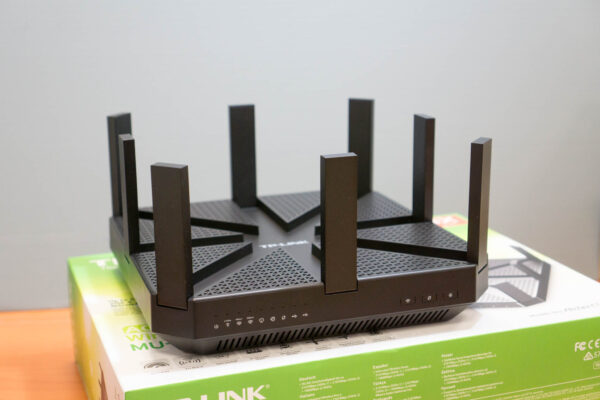It was a little eerie to see Wi-Fi routers taking on spider-like shapes initially, but the era of eight-antennas is now coming of age. To satisfy consumers’ demand for ever increasing Wi-Fi speeds, TP-Link has brought their new Archer C5400 to the party. This is a 802.11ac AC5400 tri-band MU-MIMO gigabit router. In short, it has all the works.
The TP-Link Archer C5400 delivers 1000Mbps on the 2.4GHz band, and an impressive 2167Mbps on each of the two 5GHz band, for a total of an outstanding 5334Mbps of Wi-Fi bandwidth. The router will also support MU-MIMO, but just not right now, through a promised firmware update in the future.
MU-MIMO, or Multi-User, Multiple-Input, Multiple-Output. MU-MIMO is the technology that supports transmission of data streams to multiple client device at the same instance in time. This feature also requires all client devices to support the technology.
The new Archer C5400’s physical design resembles the older Archer C3200. The main difference between the two is in the number of antennas: the Archer C5400 has eight antennas while the Archer has six antennas.
The antennas, all external, fold down into grooves on the top of the router. The router itself is a compact boxy shape measuring 230 x 230 x 43mm. It is powered by the included 12V/5A power adapter.
A RJ45 Ethernet cable is also provided in the box, which you can use for the uplink connection to your broadband Internet.
There are plenty of LED status indicators on the front side, including individual Wi-FI indicators for 2.4GHz band and each of the 5GHz band. Unfortunately, there are no front-side indicators for the wired Gigabit Ethernet ports which are located on the back.
There are also three buttons to control Wi-Fi on/off, WPS, as well as LED on/off. The last one is turns off all the LED lights in case you cannot stand to have them lighted up inside a darkened room.
On the back, you’ll find two USB ports, one of which is USB 3.0, the WAN uplink port, 4 LAN ports, a physical power button, the DC input port and a reset button. All the WAN and LAN ports support Gigabit Ethernet.
Setting up teh TP-Link Archer C5400 is really easy, as we pretty much expect it should be. Just plug-in the WAN cable to your broadband connection. Plug-in the power, and turn on the unit. Wait for a while for the router to boot up. Then, connect to it from your notebook via Wi-Fi. You will find the default SSID and password printed on the underside of the router.
The browser based setup wizard is easy to follow.
I found the web management interface to be generally very easy to use and understand. The main dashboard provides a quick summary of your network.
In advanced settings, you can individually configure each of the Wi-Fi bands. This include details like the channel width, transmit power, and 802.11 operating modes. I like that the transmit power can be configured, so one can optimise the Wi-Fi coverage in conjunction with other routers that might be operating in the vicinity.
The TP-Link Archer C5400 supports the option of connecting a 3G/4G modem stick directly to its USB port so you can use the cellular broadband as your Internet connection in the even that your regular wired broadband is unavailable.
Not unlike other routers, the USB ports can otherwise also be used for connecting storage or printers.
Guest Wi-Fi network is individually configurable on each of the three Wi-Fi bands. You can customise the SSID for each one of them. However, they will all share the same security settings (no security, or a common WPA/WPA2 password).
There are the usual controls for QoS, security, and parental controls. You can also configure VPN server, with support for OpenVPN and PPTP VPN.
For those who want to really fine-tune their Wi-Fi performance, the Archer C5400 provides access to various operating parameters. Few other Wi-Fi routers provide this level of control.
Despite all the configurability, the Archer C5400 doesn’t have any scheduling features.
In terms of performance, the Archer C5400 is really good.. The LAN to LAN and WAN to LAN throughput easily sailed past 900Mbps.
Actual Wi-Fi throughput on the 2.4GHz was about 200Mbps, and over 400Mbps on 5GHz. The Wi-Fi speeds expectedly fell far short of claimed bandwidth, but I should point out that it’s on par with the best Wi-Fi routers.
Under the hood, the Archer C5400 runs on a powerful 1.4GHz dual-core processor and supported by three co-processors, one for each Wi-Fi band. The main processor might not be the fastest, beaten by routers such as the Linksys WRT1900AC and Netgear Nighthawk X4S AC2600, but the co-processors make up for it.
The TP-Link Archer C5400 retails for S$399. It is also available as a bundle with the T9UH AC1900 High Gain Wireless Dual Band USB Adapter at S$429.
Conclusion
The TP-Link Archer C5400 is a speedy 802.11ac AC5400 Wi-Fi tri-band MU-MIMO gigabit router. The web management interface is easy to use, yet offers options for advanced users to tweak various Wi-Fi operating parameters.
Pros:
- Very fast
- Compact design with foldable antennas
- Easy to use web management interface
- Highly configurable Wi-Fi operating parameters
Cons:
- MU-MIMO is not yet available

